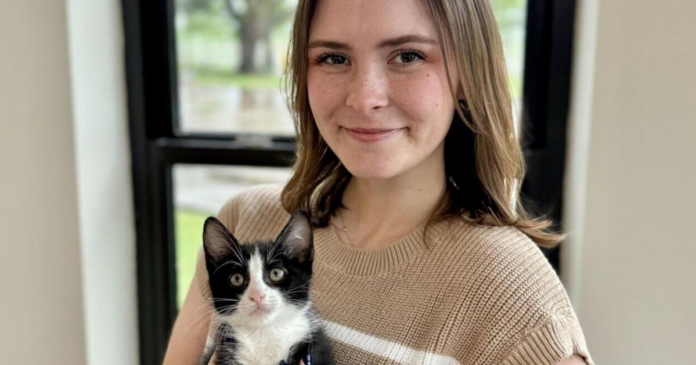LSU alumna Jen Hollas started working at Companion Animal Alliance Baton Rouge over four years ago as a student part-time worker. Originally from Houston, but a longtime resident of California, Hollas stayed in Baton Rouge after graduation to continue working for Companion Animal Alliance.
She started as a pet adoption counselor, moved to rescue manager, and now she is the communications and events senior manager. What started as a part-time job became her occupation and her passion.
This interview was edited for length and clarity.
How has your role and involvement changed since you started with Companion Animal Alliance?
After being one of our adoption counselors, I was our rescue manager for a little bit. We do flight transports with the Bissell Pet Foundation twice a month, and I was in charge of that. We work with all of our local rescues here, like Friends of the Animals Baton Rouge and Dante’s Hope.
It was a bit of a transition going from the operational side of the shelter to an administrative role. It’s definitely a different perspective, but I do miss interacting with the animals.
What is the operational structure like at the shelter?
We’re the open intake shelter for East Baton Rouge Parish. We took over animal sheltering from Animal Control in 2010, so this is our 15th anniversary. Animal Control is currently still in charge of picking up the animals and handling the law enforcement side of animal cruelty. We shelter about 9,000 animals per year.
What should more people know about Companion Animal Alliance?
People don’t expect that we’re still involved with animal control operations, so they don’t realize how many animals we take in, or the types of conditions that we see animals in every single day.
We also are not a no-kill shelter. With the amount of animals that we have coming in every single day, it’s just not possible for us. We’re actually trying to get away from the no-kill versus kill shelter language, because we find that it villainizes the shelter and the animal shelter workers, who are doing everything day in and day out to avoid those decisions.
We focus on letting people know everything that we’re doing to get animals out the door.
We have an extensive foster program, local rescues and rescues across the country to get these animals out and into homes. We also have reduced fee adoption events. Every single Tuesday, we have a $10 Tuesday special for all of our animals that are completely ready to go. It has turned into our busiest day of the week.
What are some other programs that the shelter offers to the community?
We have so many different foster opportunities and volunteer opportunities for all ages. We host a summer camp every single summer for ages 7 to 11.
And then, of course, we also try to provide as many resources as we can to our community. Sometimes people aren’t able to afford pet food for their animals, so we have a pet food pantry that we host. We also do vaccine clinics and spay/neuter outreach in the community.
When the shelter receives an animal that is in bad shape, how does the staff handle that process?
We have an in-house vet clinic, so if it’s an emergency case during operating hours, we can take care of it here. However, if it’s anything after hours that Animal Control has picked up, they’ll take it straight to the LSU Vet Hospital and triage it and then send it over to us.
We do biweekly rotations with the LSU vet students, so they get a chance to learn animal sheltering and shelter medicine.
What do you love about working for Companion Animal Alliance?
It’s hard to pick one thing for sure. Everyone that you talk to here is going to say the animals. That’s why we’re all here.
We all have a passion to help the animals, to be around them, and it’s such a rewarding job to be able to see them come into the shelter and then go out to their new home.
How has social media changed the game for animal welfare?
People actually get to see more of what we do — a little bit more behind the scenes now.
It’s a really powerful tool, especially when we’re over capacity and we really need emergency fosters. We’ll make that call out on social media, and our community absolutely steps up for us.
I have a LSU intern who does our social media currently, so it’s fun for her to be able to get pictures and video of the animals to capture their personalities for our website. It gives people a glimpse into who that animal is.
How can someone in the community help Companion Animal Alliance?
We have our volunteer program. Volunteers have to sign up on our website by making an account, attending orientation, taking a tour of the building and meeting the volunteer manager for guidelines and expectations.
Once that orientation is complete, they’re good to go. Volunteers can socialize with dogs, take dogs on walks and hang out with cats. We have the less glamorous jobs, like laundry and dishes.
We also have a program, Date-a-Dog, where you can take a shelter dog on a date for the day, like to the LSU lakes or to get pup cups. This helps get the dog out of the shelter and allows us to get information on how they behave outside of the shelter.




